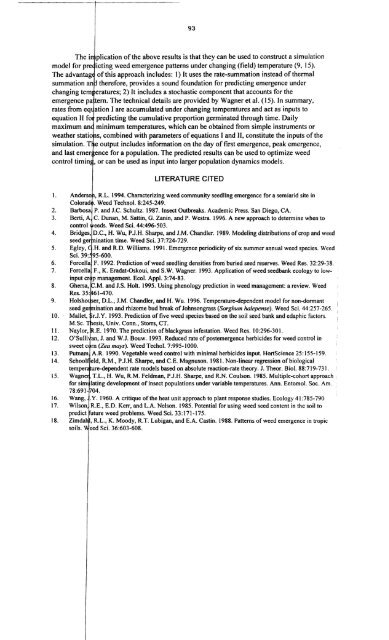Vol. 51â1997 - NorthEastern Weed Science Society
Vol. 51â1997 - NorthEastern Weed Science Society
Vol. 51â1997 - NorthEastern Weed Science Society
You also want an ePaper? Increase the reach of your titles
YUMPU automatically turns print PDFs into web optimized ePapers that Google loves.
93<br />
The i plication of the above results is that they can be used to construct a simulation<br />
model for pre icting weed emergence patterns under changing (field) temperature (9, 15).<br />
The advantag of this approach includes: I) It uses the rate-summation instead of thermal<br />
summation an therefore, provides a sound foundation for predicting emergence under<br />
changing tern eratures; 2) It includes a stochastic component that accounts for the<br />
emergence pa tern. The technical details are provided by Wagner et al. (15). In summary,<br />
rates from eq ation I are accumulated under changing temperatures and act as inputs to<br />
equation II fo predicting the cumulative proportion germinated through time. Daily<br />
maximum an minimum temperatures, which can be obtained from simple instruments or<br />
weather stati s, combined with parameters of equations I and II, constitute the inputs ofthe<br />
simulation. T e output includes information on the day of first emergence, peak emergence,<br />
and last emer ence for a population. The predicted results can be used to optimize weed<br />
control timin ,or can be used as input into larger population dynamics models.<br />
LITERATURE CITED<br />
I. Anderso ,R.L. 1994. Characterizing weed community seedling emergence for a semiarid site in<br />
Colorad . <strong>Weed</strong> Techno!' 8:245-249.<br />
2. Barbosa P. and J.C. Schultz. 1987. Insect Outbreaks. Academic Press. San Diego, CA.<br />
3. Berti, A C. Dunan, M. Sattin, G. Zanin, and P. Westra. 1996. A new approach to determine when to<br />
control eeds, <strong>Weed</strong> Sci. 44:496-503.<br />
4. Bridges, D.C., H. Wu, Pol.H.Sharpe, and J.M. Chandler. 1989. Modeling distributions of crop and weed<br />
seed ge ination time. <strong>Weed</strong> Sci. 37:724-729.<br />
5. Egley, .H. and R.D. Williams. 1991. Emergence periodicity of six summer annual weed species. <strong>Weed</strong><br />
Sci. 39: 95-600.<br />
6. Forcella F. 1992. Prediction of weed seedling densities frorriburied seed reserves. <strong>Weed</strong> Res. 32:29-38.<br />
7. Forcell F., K. Eradat-Oskoui, and S.W. Wagner. 1993. Application of weed seedbank ecology to lowinput<br />
cr p management. Ecol, Appl. 3:74-83.<br />
8. Ghersa, .M. and J.S. Holt. 1995. Using phenology prediction in weed management: a review. <strong>Weed</strong><br />
Res. 35: 61-470.<br />
9. Holsho ser, D.L., J.M. Chandler, and H. Wu. 1996. Temperature-dependent model for non-dormant<br />
seed ge ination and rhizome bud break of Johnsongrass (Sorghum halepense). <strong>Weed</strong> Sci. 44:257-265.<br />
10. Mallet, r.J.Y. 1993. Prediction oftive weed species based on the soil seed bank and edaphic factors.<br />
M.Sc. esis, Univ. Conn., Storrs, CT.<br />
11. Naylor, .E. 1970. The prediction of blackgrass infestation. <strong>Weed</strong> Res. 10:296-301.<br />
12. O'Sulli an, J. and W.J. Bouw. 1993. Reduced rate of postemergence herbicides for weed control in<br />
sweet c m (Zea mays). <strong>Weed</strong> Techol. 7:995-1000.<br />
13. Putnam A.R. 1990. Vegetable weed control with minimal herbicides input. Hort<strong>Science</strong> 25:155-159.<br />
14. School eld, R.M., Pol.H.Sharpe, and C.E. Magnuson. 1981. Non-linear regression of biological<br />
tempe re-dependent rate models based on absolute reaction-rate theory. J. Theor. Biol. 88:719-73] .<br />
15. Wagne T.L., H. Wu, R.M. Feldman, P.I.H. Sharpe, and R.N. Coulson. 1985. Multiple-cohort approach.<br />
for sim lating development of insect populations under variable temperatures. Ann. Entomol. Soc. Am.<br />
78:691- 04.<br />
16. Wang, .Y. 1960. A critique of the heat unit approach to plant response studies. Ecology 41:785-790<br />
17. Wilson R.E., E.D. Kerr, and L.A. Nelson. 1985. Potential for using weed seed content in the soil to<br />
predict ture weed problems. <strong>Weed</strong> Sci. 33:171-175.<br />
18. Zimd , R.L., K. Moody, R.T. Lubigan, and E.A. Castin. 1988. Patterns of weed emergence in tropic<br />
soils. eed Sci. 36:603-608.
















